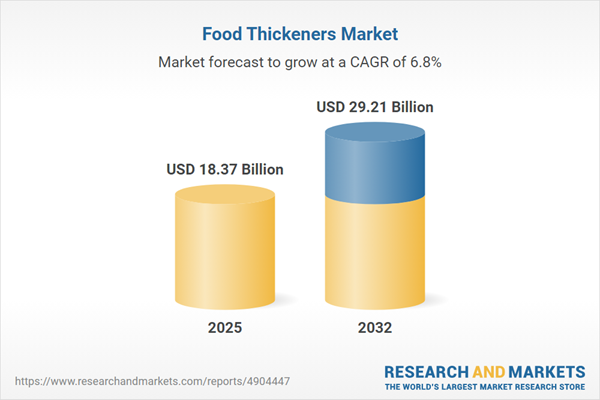Speak directly to the analyst to clarify any post sales queries you may have.
The global food thickeners market is undergoing pivotal transformation, driven by shifting consumer expectations, increasing regulatory scrutiny, and rapid innovation in formulation technologies. Senior decision-makers require actionable insight into market opportunities and operational challenges to secure competitive advantage.
Market Snapshot: Food Thickeners Market Overview
The Food Thickeners Market grew from USD 17.28 billion in 2024 to USD 18.37 billion in 2025. It is expected to continue growing at a CAGR of 6.77%, reaching USD 29.21 billion by 2032.
Scope & Segmentation of the Food Thickeners Market
- Product Types: Hydrocolloid-Based Thickeners (including pectin, xanthan gum, carrageenan, guar gum, alginate), Protein-Based Thickeners (such as casein, gelatin, soy protein), Starch-Based Thickeners (arrowroot, cornstarch, potato, rice, tapioca, wheat flour), Synthetic Thickeners (cellulose ethers, polyacrylamide)
- Form: Granules, Liquid concentrates and premixes, Powdered forms (drum-dried or spray-dried), Tableted capsules
- Source: Plant-based, Microbial-based, Animal-based inputs
- Applications: Bakery (bread, cakes, cookies), Confectionery (candies, jams), Beverages, Dairy (cheese, yogurt, ice cream), Sauces and Dressings (pasta sauce, salad dressing, marinades), Soups and Broths (clear, cream-based)
- End-Use Industries: Food Processing, Foodservice, Household, Cosmetics, Pharmaceuticals
- Distribution Channel: Online, Offline (bulk procurement, e-commerce for niche segments)
- Geographic Regions: Americas (including North and Latin America), Europe, Middle East & Africa, Asia-Pacific (China, India, Japan, and others)
Key Takeaways for Senior Decision-Makers
- Adoption of hydrocolloid and protein-based thickeners is expanding as food manufacturers respond to clean-label and functional nutrition trends, prioritizing plant-based and minimally processed ingredients.
- Collaborative innovation between suppliers and producers is accelerating the development of customized thickening systems, supporting both cost-efficiency and sustainable product alternatives.
- Regional variations in consumer preferences and regulatory requirements shape localized R&D investments, particularly in Asia-Pacific and Europe, fostering market resilience and diversification in ingredient sourcing.
- Digital process controls and data analytics are streamlining production by enabling real-time monitoring and adjustment, helping maintain consistent product quality and accelerating new product launches.
- Sustainability is increasingly central, with companies valorizing byproducts and minimizing environmental impact through greener solvents and energy-efficient extraction processes.
Food Thickeners Market: Tariff Impact and Supply Chain Adaptation
Recent tariff changes in the United States have altered global sourcing strategies for food thickeners, prompting manufacturers to reassess import dependencies and procurement models. These policy shifts have encouraged nearshoring, increased domestic raw material utilization, and investments in regional processing capabilities. Supply chain resilience remains a strategic priority amid changing trade dynamics.
Methodology & Data Sources
This report employs a dual-methodology approach. Extensive secondary research covers academic publications, trade data, and regulatory filings, complemented by primary research through interviews with industry leaders and specialists. Data is validated through cross-verification and expert review to ensure reliability.
Why This Report Matters: Executive Value
- Receive comprehensive analysis of product, technology, and end-market trends for strategic planning and differentiation initiatives.
- Gain region-specific insights that inform supply chain optimization, compliance planning, and market entry or expansion strategies.
- Access detailed segmentation mapping for targeted product innovation and partnership evaluation, enhancing portfolio resilience.
Conclusion
Integrating advanced technologies, sustainability priorities, and regulatory alignment will be key for sustained success in the evolving global food thickeners market. This analysis equips senior executives to balance innovation with risk management and capitalize on new growth opportunities.
Additional Product Information:
- Purchase of this report includes 1 year online access with quarterly updates.
- This report can be updated on request. Please contact our Customer Experience team using the Ask a Question widget on our website.
Table of Contents
3. Executive Summary
4. Market Overview
7. Cumulative Impact of Artificial Intelligence 2025
Companies Mentioned
The companies profiled in this Food Thickeners market report include:- ABITEC
- Archer Daniels Midland Company
- Ashland Global Holdings Inc.
- Brenntag SE
- Cargill, Incorporated
- Catalynt
- Darling Ingredients Inc.
- Deosen Biochemical
- Emsland Group
- FoodCare Co.,Ltd.
- GNF CHEMICAL CO.,LTD.
- Goshu Yakuhin Co.,Ltd.
- HH Industries Limited
- Hosokawa Alpine Group
- Ingredion Incorporated
- International Flavors & Fragrances Inc
- Jungbunzlauer Suisse AG
- Kent Precision Foods Group, Inc.
- Kerry Group plc
- Lyons Health Labs
- Maruzen Chemicals Co., Ltd.
- Morinaga Nutritional Foods
- Naturex S.A.
- Nexira
- Roquette Frères S.A.
- Solvay S.A.
- SUNUS CO., LTD.
- Taiyo Kagaku Co.,Ltd.
- Tate & Lyle PLC
Table Information
| Report Attribute | Details |
|---|---|
| No. of Pages | 199 |
| Published | November 2025 |
| Forecast Period | 2025 - 2032 |
| Estimated Market Value ( USD | $ 18.37 Billion |
| Forecasted Market Value ( USD | $ 29.21 Billion |
| Compound Annual Growth Rate | 6.7% |
| Regions Covered | Global |
| No. of Companies Mentioned | 30 |









